What Can You Feed green neon tetra fish From Home?
This post may contain affiliate links.
Aquarists often marvel at the vibrant colors of the green neon tetra, a popular choice for aquascapers. But have you ever wondered what fuels their dazzling appearance?
To keep these tiny wonders thriving, it’s essential to understand their dietary needs. In their natural habitat, neon tetras feed on small invertebrates and plankton. Replicating this diet in a home aquarium is crucial for maintaining their health and enhancing their colors.
So, what food options are available for neon tetra owners? From commercial flakes to live foods, we’ll explore the best choices to keep your fish healthy and vibrant.
Key Takeaways
- Understand the natural diet of green neon tetras and how to replicate it in a home aquarium.
- Explore various food options, including commercial products and live foods.
- Learn how to maintain the health and enhance the colors of your neon tetras.
- Discover the importance of a balanced diet for tetras in captivity.
- Find out how to keep your fish thriving with the right feeding strategies.
Understanding Green Neon Tetras
To care for green neon tetras, it’s essential to understand their origins and natural behaviors. Green neon tetras are small, schooling fish that thrive in specific conditions.
What Are Green Neon Tetras?
Green neon tetras are a species of freshwater fish native to the blackwater environments of South America, particularly the upper Orinoco and Negro rivers. They are known as tetras, a common name for several species of small fish.
Natural Habitat and Behavior
Their natural habitat is characterized by slow-moving water with abundant leaf litter and driftwood. In the wild, they swim in schools and feed on small particles in the water column. Understanding their natural environment helps replicate appropriate feeding conditions in home aquariums.
Natural Diet of Green Neon Tetras
Understanding the natural diet of green neon tetras is crucial for their health in captivity. In their natural habitat, these small fish feed on tiny organisms that are rich in nutrients.
Wild Feeding Habits
Green neon tetras are omnivores, feeding on small invertebrates, algae, and zooplankton in the wild. Their diet consists of tiny crustaceans, insect larvae, and other small organisms that are abundant in their natural habitat.
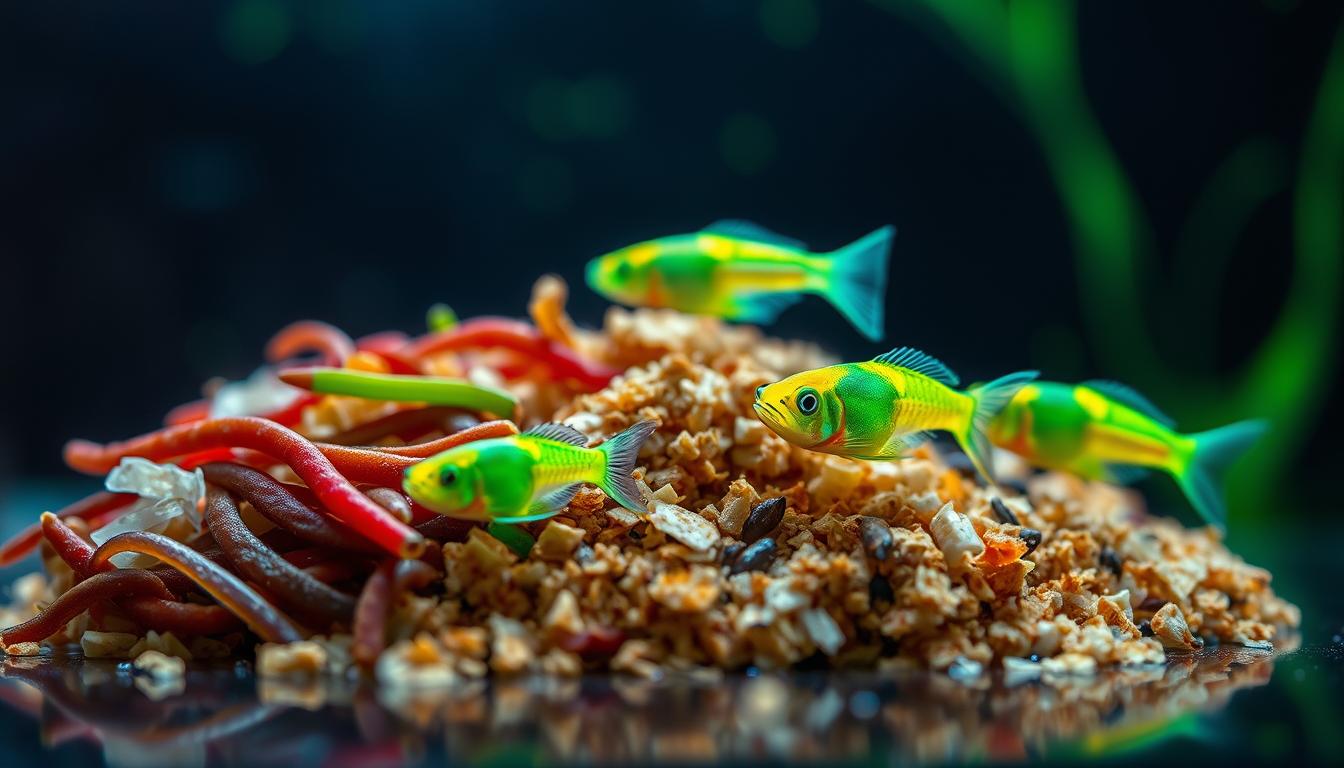
Nutritional Requirements
To replicate their natural diet, it’s essential to provide green neon tetras with a balanced diet rich in proteins, vitamins, and minerals. A proper diet should include approximately 40-50% protein content, essential fatty acids, and micronutrients like carotenoids to maintain their vibrant coloration and overall health.
| Nutrient | Importance | Sources |
|---|---|---|
| Protein | Supports active metabolism | Crumbled flakes, nano pellets |
| Essential Fatty Acids | Maintains nervous system and color | Freeze-dried tubifex worms |
| Micronutrients (Carotenoids) | Enhances natural coloration | Specialized nano fish foods |
Commercial Food Options
Commercial food options play a crucial role in maintaining the well-being of green neon tetras in home aquariums. A nutritious staple diet is essential for their health and vibrancy.
Dry Foods: Flakes and Micro Pellets
Dry foods such as flakes and micro pellets are a convenient and nutritious option for green neon tetras. When selecting dry foods, it’s essential to choose products that are specifically formulated for nano fish like green neon tetras, considering their small size and nutritional needs.
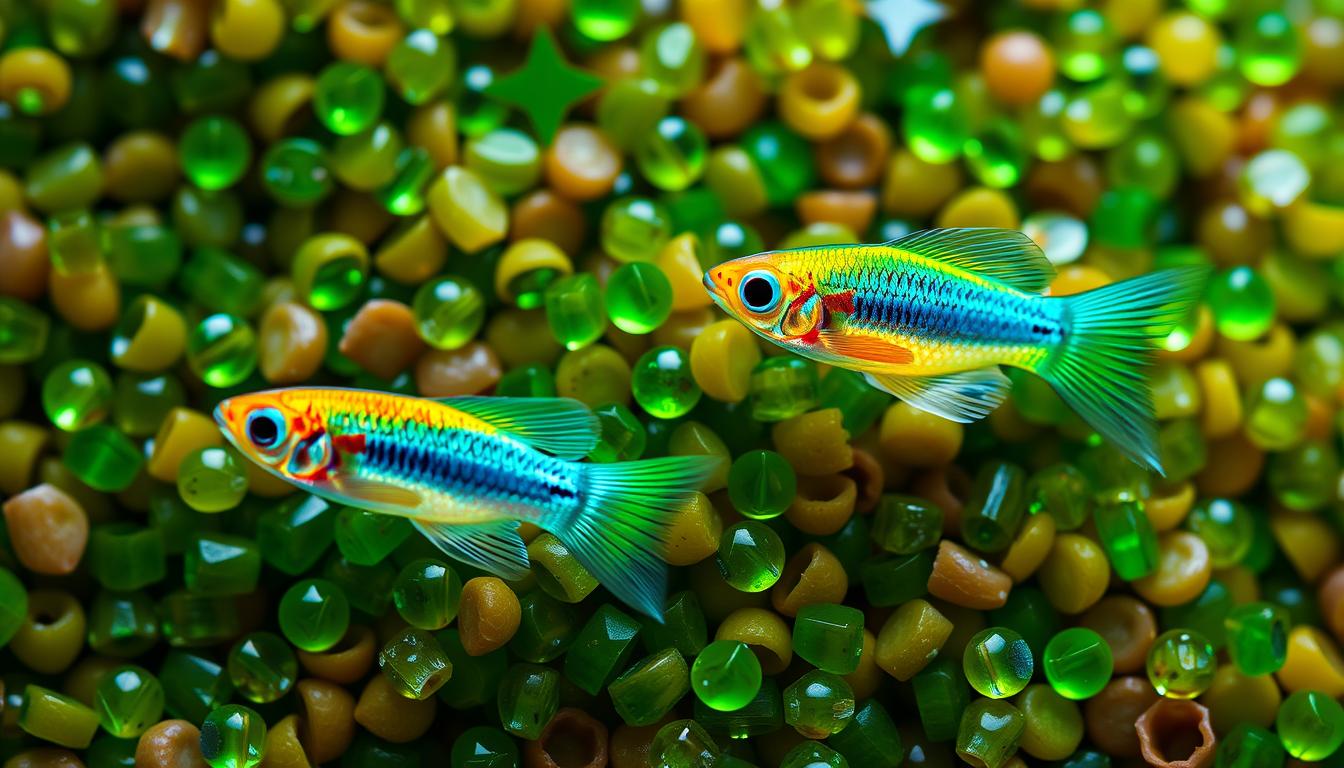
Freeze-Dried Foods
Freeze-dried foods like tubifex worms are a nutritious supplement to the diet of green neon tetras. These foods are rich in proteins and can be used to add variety to their diet.
Specialized Nano Fish Foods
Several manufacturers produce specialized nano fish foods that cater to the unique needs of green neon tetras. These foods typically contain higher levels of proteins and fats to support their fast metabolism and include natural color enhancers to maintain their vibrant colors.
The particle size of these foods is carefully controlled to ensure they’re appropriate for the tiny mouths of nano fish, making them an ideal choice for green neon tetras.
Live and Frozen Foods
To keep your green neon tetras healthy and vibrant, consider adding live and frozen foods to their meals. These foods provide essential nutrients and stimulate their natural hunting behaviors.
Baby Brine Shrimp
Baby brine shrimp are an excellent live food source for green neon tetras. They are rich in nutrients and easy to digest.
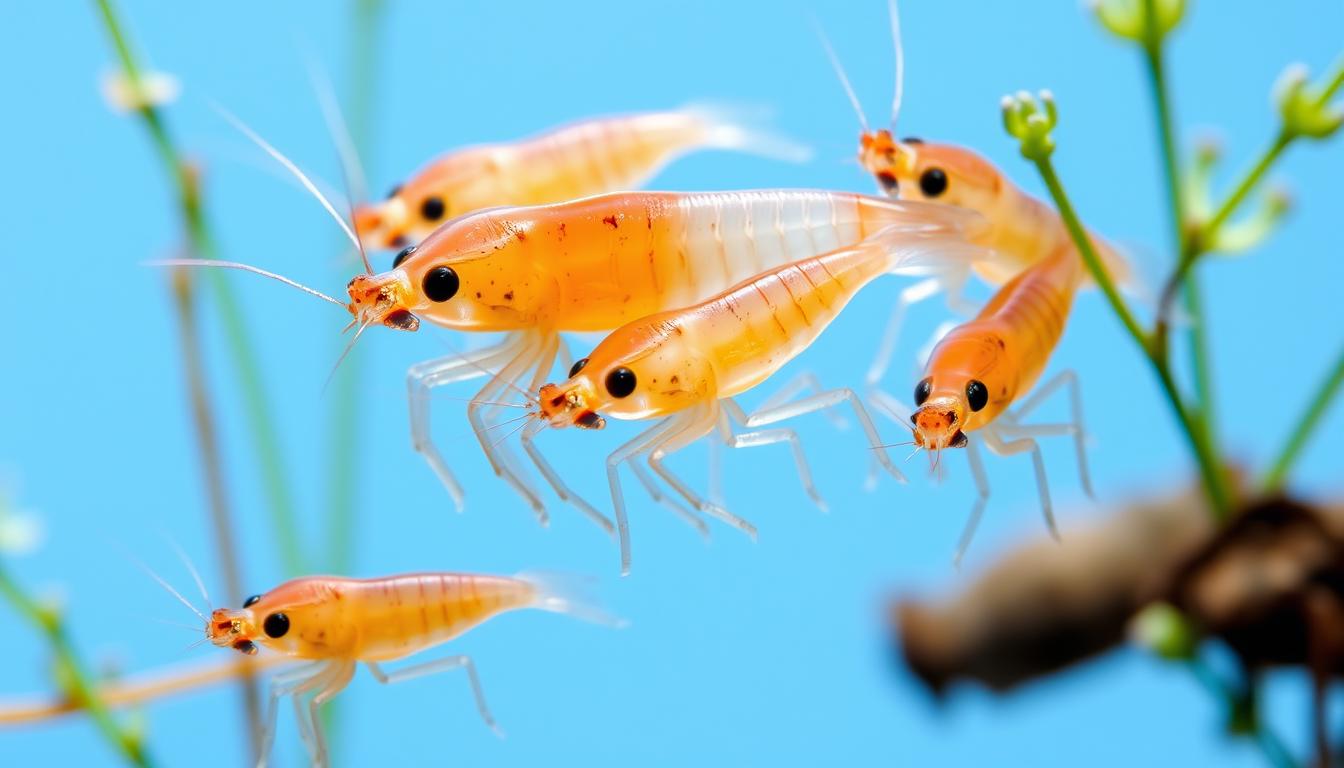
Daphnia and Cyclops
Daphnia and cyclops are small crustaceans that serve as nutritious live or frozen foods. They are rich in proteins and help promote healthy growth in tetras.
Other Suitable Live Foods
Besides baby brine shrimp, daphnia, and cyclops, other live foods can diversify the diet of green neon tetras. Options include microworms, vinegar eels, grindal worms, and mosquito larvae from clean water sources. Rotating these foods ensures a well-rounded diet that mimics nature.
Homemade Food Options for Green Neon Tetras
Green neon tetras thrive on a diverse diet, and creating homemade food options can be a rewarding experience for aquarium enthusiasts. By preparing food at home, you can ensure that your tetras receive a nutrient-rich diet tailored to their specific needs.
DIY Fish Food Recipes
Creating DIY fish food recipes can be a fun and creative way to provide your green neon tetras with a varied diet. You can use ingredients like vegetables, fruits, and proteins to create a balanced mix. For example, a mixture of cooked peas, spinach, and finely chopped shrimp can provide a nutrient-rich meal for your tetras.
Cultivating Infusoria and Microorganisms
Cultivating infusoria and microorganisms is another effective way to provide your green neon tetras with a nutritious diet. Infusoria cultures can be started at home using simple ingredients like lettuce, banana peels, or hay. These cultures provide microscopic organisms that closely resemble the natural food sources of green neon tetras, making them an ideal food source, especially for fry and juvenile fish.
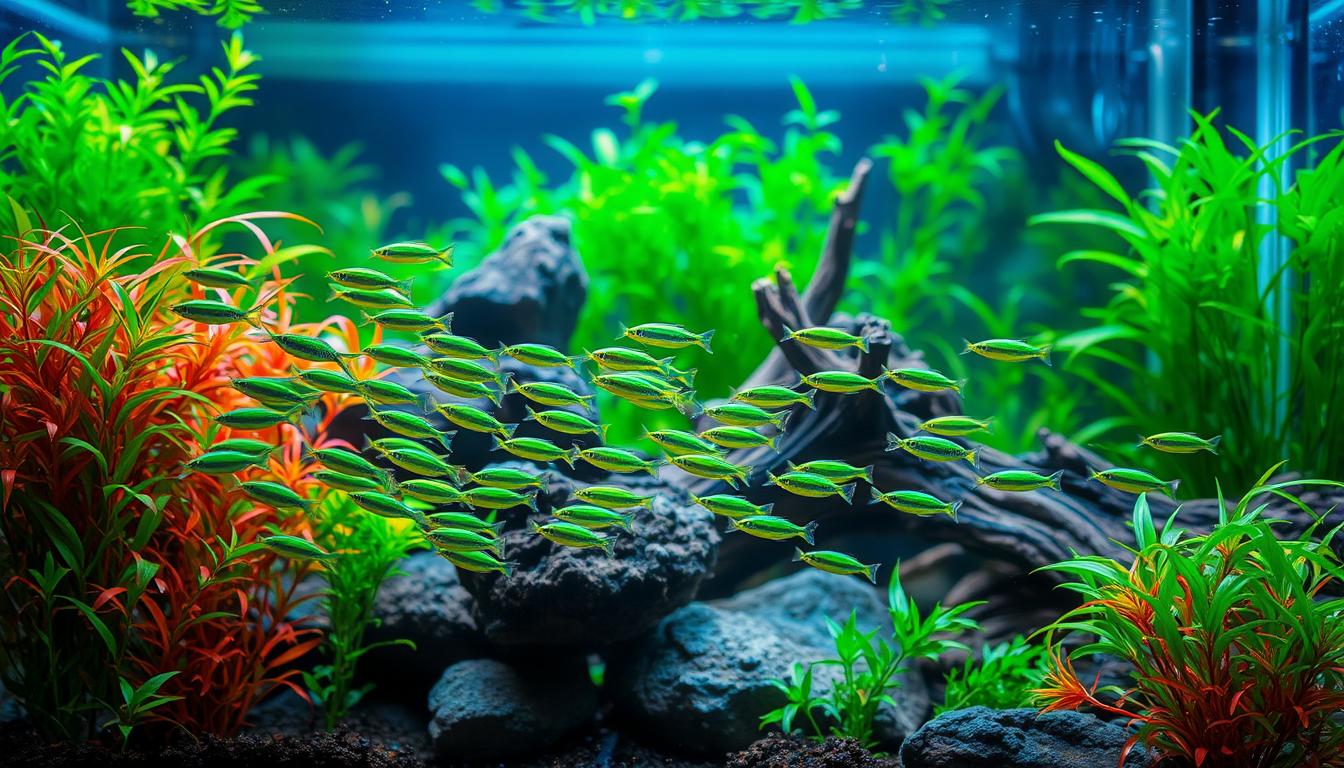
Feeding Schedule and Amounts
To keep your green neon tetras healthy, it’s essential to understand how often and how much to feed them. A proper feeding schedule helps maintain their overall health and prevents common feeding-related issues.
Feeding Frequency
For neon tetras, it’s recommended to feed them 2-3 times a day. This frequency mimics their natural feeding behavior in the wild, ensuring they receive the nutrients they need without overloading the tank.
Portion Control
The golden rule for feeding green neon tetras is to offer only what they can consume in 2-3 minutes. Overfeeding is a common mistake that leads to poor water quality and health issues in the aquarium. For a small school, a pinch of food about the size of a pea is typically sufficient per feeding.
| Feeding Frequency | Portion Size | Benefits |
|---|---|---|
| 2-3 times a day | Pinch of food (pea-sized) | Mimics natural feeding behavior, prevents overfeeding |
| Once a day | Large amount | Can lead to overfeeding, poor water quality |
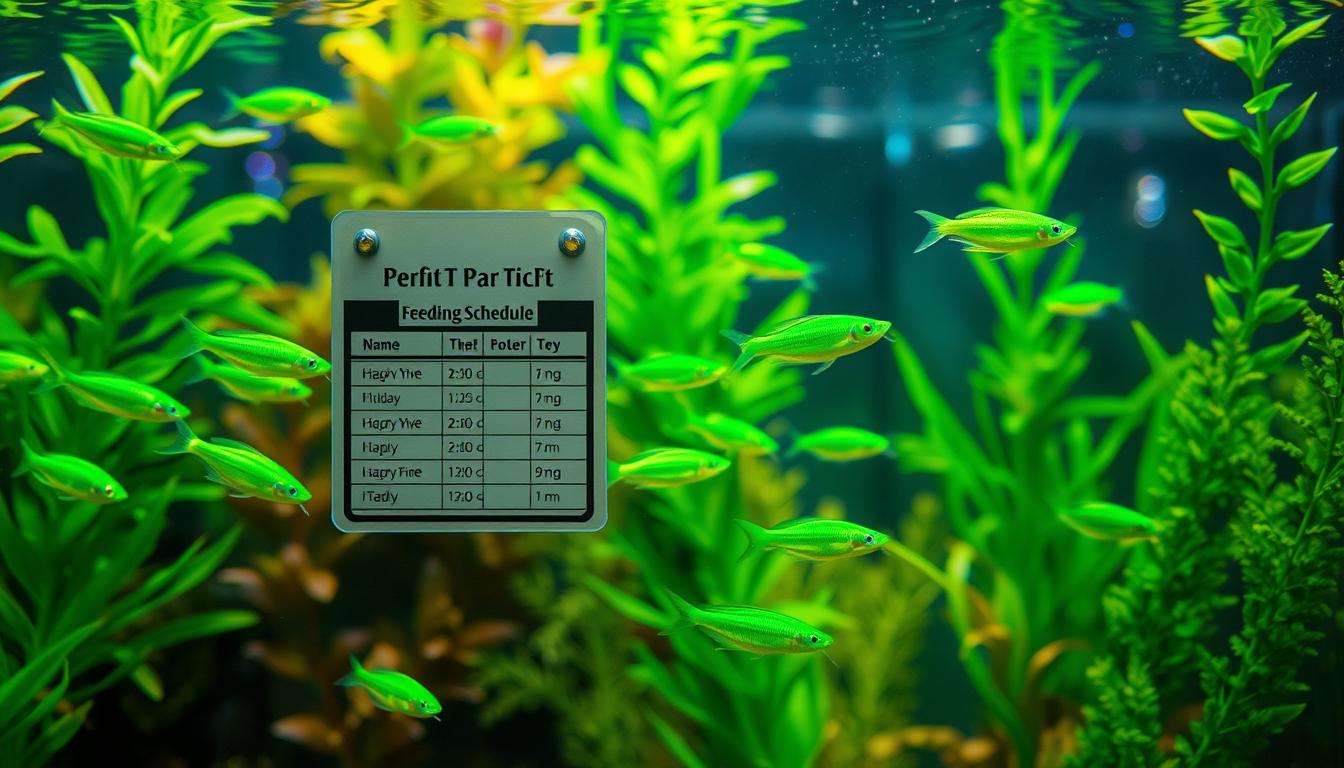
Special Dietary Considerations
Understanding the special dietary needs of green neon tetras is essential for their overall health, successful breeding, and raising healthy fry. Green neon tetras have specific requirements that vary across different stages of their life cycle.
Feeding Fry and Juveniles
After the eggs hatch, the fry require very small, nutritious food. Infusoria or commercial fry food are suitable for the initial feeding stages. As they grow, they can be gradually introduced to small live foods like baby brine shrimp.
To protect the eggs from predation, consider using a layer of netting underneath the spawning material. This prevents larger fish from accessing the eggs and fry that fall through, thereby increasing the survival rate of the fry.
Breeding Conditioning Diet
Conditioning green neon tetras for breeding requires a specialized high-protein diet to promote egg and sperm development. Live foods such as baby brine shrimp, daphnia, and bloodworms are particularly effective for this purpose.
- Increasing feeding frequency and quality about 2 weeks before expected spawning helps females develop eggs.
- After spawning, parents should be removed from the spawning tank and returned to their regular feeding schedule.
- A varied diet rich in essential fatty acids supports successful reproduction and viable eggs.
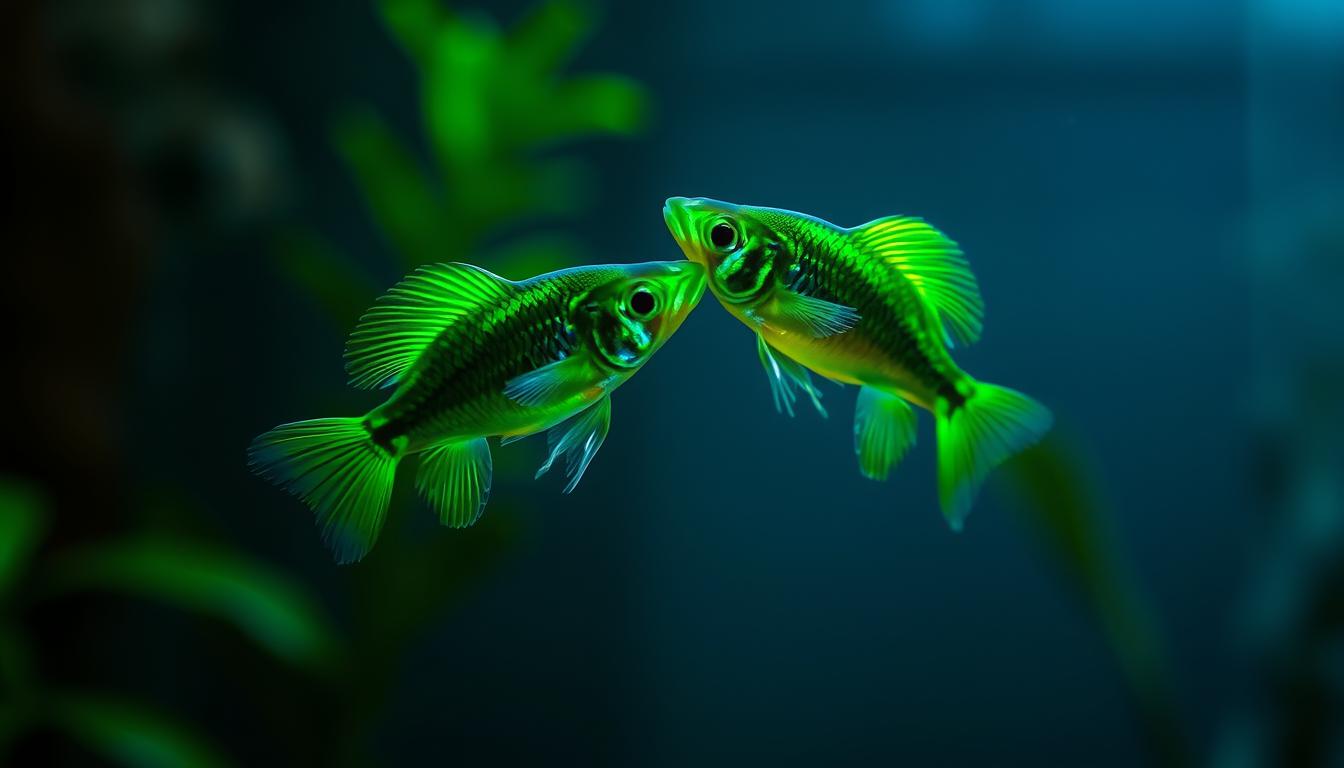
| Dietary Component | Importance | Food Examples |
|---|---|---|
| High-Protein Foods | Promotes egg and sperm development | Baby brine shrimp, daphnia, bloodworms |
| Essential Fatty Acids | Supports successful reproduction and viable eggs | Live foods, specialized fish foods |
| Varied Diet | Ensures overall health and well-being | Combination of live, frozen, and dry foods |
Enhancing Color Through Diet
To keep green neon tetras looking their best, it’s essential to understand how their diet affects their coloration. The vibrant colors of these fish can be enhanced through a diet rich in specific nutrients.
Color-Enhancing Foods
Several natural foods contain pigments that can enhance the coloration of green neon tetras. For instance, spirulina and chlorella are known to provide natural blue-green enhancing compounds.
Some key color-enhancing foods include:
- Spirulina and other algae
- Crustaceans like krill and shrimp containing astaxanthin
- Fresh vegetables such as spinach and peas offering lutein and other carotenoids
Natural Pigment Sources
The intense blue lateral stripe in Paracheirodon spp. is not just visually striking; it may have evolved as a predator evasion strategy. Incorporating natural pigment sources into their diet can enhance this coloration.
A diet that includes these natural color enhancers can produce more natural-looking results than synthetic alternatives, ensuring that your neon tetras display their best colors.
Common Feeding Mistakes to Avoid
One of the most critical aspects of keeping green neon tetras healthy is avoiding common feeding errors. Feeding them requires attention to detail to ensure their well-being.
Overfeeding Issues
Overfeeding is a common mistake that can lead to water quality issues in the aquarium. When green neon tetras are overfed, excess food decomposes, releasing harmful toxins into the water.
- Feed your neon tetras sparingly to avoid overfeeding.
- Monitor the aquarium’s water quality regularly.
Inappropriate Food Sizes
Offering food particles that are too large can cause feeding difficulties for fish like green neon tetras. Their small mouths struggle with standard-sized foods, leading to wasted food and potential health issues.
Crushing flakes or opting for micro-sized foods can help ensure that your neon tetras eat comfortably. Observing their feeding behavior will help you determine if adjustments are needed.
Conclusion: Creating a Balanced Diet for Healthy Green Neon Tetras
To keep your green neon tetras healthy and thriving, it’s vital to understand their dietary needs and provide a balanced feeding regimen. A well-balanced feeding approach combines commercial, frozen, live, and homemade food options to provide complete nutrition for these fish.
Establishing a consistent feeding routine that mimics natural feeding patterns supports optimal health and coloration. By avoiding common feeding mistakes and tailoring the diet to the specific needs of green neon tetras, aquarists can enjoy a thriving school in their home aquarium. Regular observation of fish behavior and adjusting feeding practices as needed ensures ongoing success.
With proper care and feeding, neon tetras can be among the most rewarding species to keep in the aquarium. By implementing the right feeding strategies and maintaining good water quality, you can enjoy vibrant, active, and long-lived fish in your tank.
